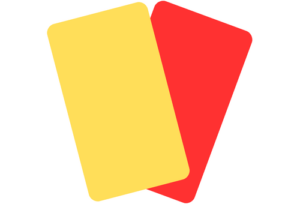Decoding the Yellow Card in Volleyball: What Every Player Should Know

Volleyball, like all sports is governed by a set of rules designed to maintain fair play and ensure the safety of all participants. Among the tools referees use to enforce these rules, the yellow card holds a special significance. Understanding the implications of receiving a yellow card is crucial for every volleyball player.
In this article we will delve into the intricacies of the yellow card, decoding its meaning, consequences and the impact it can have on a match.
The Symbolism of the Yellow Card
The yellow card in volleyball serves as a visual warning to players, coaches and even spectators. Much like its use in other sports, the yellow card signals a cautionary measure, indicating that a violation or unsportsmanlike conduct has been observed. It is not merely a piece of colored paper; rather, it is a symbol of accountability and a call for players to reassess their behavior on the court.
Common Reasons for Receiving a Yellow Card
While the specific rules can vary slightly between different volleyball organizations, there are some common reasons why a player might receive a yellow card. One primary cause is dissent or arguing with the officials. Volleyball, like any sport, relies on the judgment of referees and disputing their decisions can lead to penalties.
Another common offense leading to a yellow card is improper substitution. Volleyball has strict rules about when and how substitutions can be made and failure to adhere to these rules can result in penalties. Additionally, unsportsmanlike conduct, such as taunting opponents or using offensive language, can lead to a yellow card.
Consequences of a Yellow Card
Receiving a yellow card is not just a formality; it comes with tangible consequences that can affect both the individual player and the team. One immediate impact is the loss of a point. In many volleyball organizations, a yellow card results in the opposing team being awarded a point, penalizing the team of the offender.
Furthermore, a yellow card serves as a precursor to more severe penalties. In many cases, if a player accumulates multiple yellow cards during a match, they may be shown a red card, which results in ejection from the game. This ejection not only jeopardizes the team’s chances of winning the current match but can also have consequences for future games, as disciplinary actions may carry over.
From a psychological perspective, a yellow card can disrupt the flow and focus of a team. Teammates may become wary of the player who received the card and opponents may attempt to exploit this momentary weakness. Maintaining composure and resilience in the face of a yellow card is essential to minimize its impact on the overall performance of the team.
Preventing Yellow Cards: A Player’s Responsibility
To avoid the repercussions of a yellow card, players must prioritize sportsmanship, respect for officials and adherence to the rules. Communication is key on the volleyball court, but it should be conducted with a sense of respect and decorum. Disagreements with referees should be expressed courteously and players should refrain from using offensive language or gestures.
Understanding the rules of substitution is equally critical. Coaches and players should be well versed in the regulations surrounding substitutions to prevent unnecessary infractions. Taking the time to educate oneself and the team on the nuances of the game can go a long way in avoiding yellow cards.
The Yellow Card’s Role in Fair Play
While the yellow card is a tool for maintaining order on the volleyball court, it also plays a crucial role in upholding the principles of fair play. By penalizing unsportsmanlike conduct and rule violations, the yellow card ensures that the game is played with integrity and respect for the opponent.
Players should view the yellow card not as an impediment but as a reminder to uphold the spirit of the sport. It serves as a collective commitment to fair competition, where success is determined by skill, strategy and teamwork rather than by bending or breaking the rules.
Educating Players on Yellow Card Etiquette
Coaches and team leaders bear a significant responsibility in educating their players about the consequences of a yellow card. Emphasizing the importance of discipline, respect and adherence to the rules creates a culture of sportsmanship within the team. Regular discussions about the yellow card, its implications and strategies for preventing it can contribute to a positive and respectful team environment.
Moreover, teams can incorporate simulations or role playing exercises into their training sessions to help players practice appropriate responses to challenging situations. By preparing players mentally and emotionally for the pressures of competition, coaches can reduce the likelihood of impulsive or emotional reactions that may lead to yellow cards.
Conclusion
Decoding the yellow card in volleyball is not just about understanding its literal meaning; it’s about appreciating its significance in maintaining fair play, sportsmanship and the integrity of the game.
Every player should recognize that the yellow card is a call to reassess behavior, correct mistakes and uphold the values that make volleyball a thrilling and respected sport. By embracing the lessons taught by the yellow card, players can elevate their game and contribute to a positive and enjoyable experience for everyone involved.

